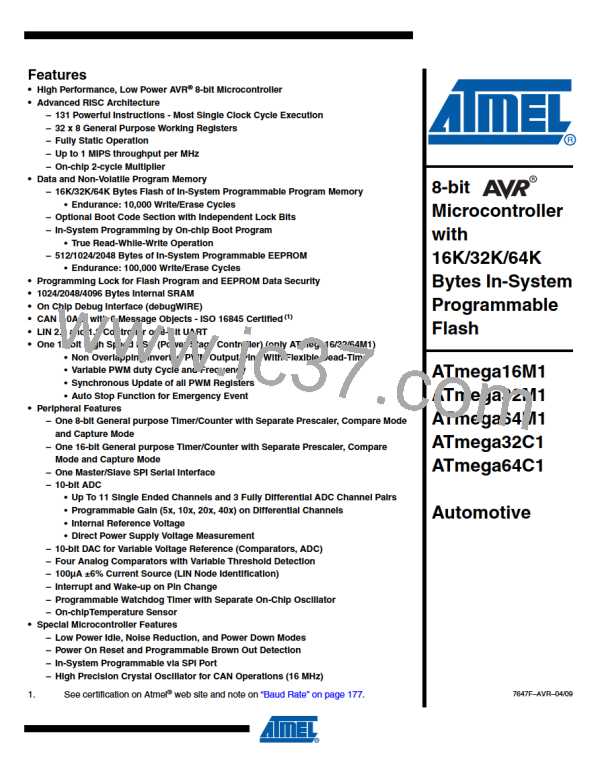5.1.3
5.1.4
5.1.5
Flash Clock – clkFLASH
The Flash clock controls operation of the Flash interface. The Flash clock is usually active simul-
taneously with the CPU clock.
PLL Clock – clkPLL
The PLL clock allows the fast peripherals to be clocked directly from a 64/32 MHz clock. A 16
MHz clock is also derived for the CPU.
ADC Clock – clkADC
The ADC is provided with a dedicated clock domain. This allows halting the CPU and I/O clocks
in order to reduce noise generated by digital circuitry. This gives more accurate ADC conversion
results.
5.2
Clock Sources
The device has the following clock source options, selectable by Flash Fuse bits as illustrated
Table 5-1. The clock from the selected source is input to the AVR clock generator, and routed to
the appropriate modules.
Table 5-1.
Device Clocking Options Select(1)
System
Clock
Device Clocking Option
PLL Input
CKSEL3..0
External Crystal/Ceramic Resonator
Ext Osc
Ext Osc
RC Osc
1111 - 1000
PLL output divided by 4 : 16 MHz / PLL driven by External
Crystal/Ceramic Resonator
Ext Osc
Ext Osc
0100
0101
PLL output divided by 4 : 16 MHz / PLL driven by External
Crystal/Ceramic Resonator
PLL / 4
Reserved
N/A
N/A
0110
0111
0011
0010
Reserved
N/A
N/A
PLL output divided by 4 : 16 MHz
Calibrated Internal RC Oscillator
PLL / 4
RC Osc
RC Osc
RC Osc
PLL output divided by 4 : 16 MHz / PLL driven by External
clock
PLL / 4
Ext Clk
Ext Clk
0001
0000
External Clock
RC Osc
Note:
1. For all fuses “1” means unprogrammed while “0” means programmed.
2. Ext Osc : External Osc
3. RC Osc : Internal RC Oscillator
4. Ext Clk : External Clock Input
The various choices for each clocking option is given in the following sections. When the CPU
wakes up from Power-down or Power-save, the selected clock source is used to time the
start-up, ensuring stable Oscillator operation before instruction execution starts. When the CPU
starts from reset, there is an additional delay allowing the power to reach a stable level before
starting normal operation. The Watchdog Oscillator is used for timing this real-time part of the
start-up time. The number of WDT Oscillator cycles used for each time-out is shown in Table
5-2. The frequency of the Watchdog Oscillator is voltage dependent as shown in “Watchdog
Oscillator Frequency versus VCC” on page 342.
30
ATmega16/32/64/M1/C1
7647F–AVR–04/09

 ATMEL [ ATMEL ]
ATMEL [ ATMEL ]